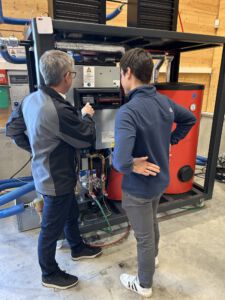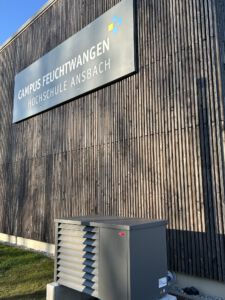Integration of heat pumps in energy systems
Research into the use of photovoltaics and dynamic electricity tariffs
Decarbonizing the heating sector is one of the biggest challenges of the energy transition in Germany. In order to sustainably reduce CO2 emissions, we need to rely on climate-friendly technologies. In addition to local heating networks and biomass-powered heating systems, heat pumps play a central role as a key technology for CO2-free heat in our buildings.
Heat pumps largely use heat from the ambient air and “refine” it into usable heat for the home. In concrete terms, this means that around 75% of the energy for the heating process is obtained directly from the environment, while only around 25% has to be supplied in the form of electricity. How efficiently a heat pump works depends on various factors. One decisive aspect is the required flow temperature: the lower this is, the more efficiently the system can be operated.
But how exactly does a heat pump work? “Put simply, a refrigerant extracts heat from the ambient air. This refrigerant is then compressed, which greatly increases its temperature. The heat obtained in this way is then transferred to the house’s heating system. Once the heat has been released, the refrigerant is expanded again, cooled down and the cycle starts all over again. This technology works in a similar way to a refrigerator, except that the process in the heat pump is reversed,” explains laboratory engineer Dipl.-Ing. (FH) Oliver Abel.
A Hoval monobloc heat pump has now been put into operation at the Feuchtwangen campus, which was supplied as a pre-installed version by the company Smartcube. The great advantage of a monobloc heat pump is its compact design, as all the important components are integrated into one device. Thanks to the pre-installed Smartcube system, installation is particularly quick and easy.
“This heat pump is used in a variety of ways at the Feuchtwangen campus. Students have the opportunity to learn about the design, functionality and operation of heat pump systems in a practical way. At the same time, the system serves as a basis for research projects. The aim is to develop algorithms that optimally integrate the operation of the heat pump into the energy system. We are researching how the heat pump can be operated efficiently with electricity from photovoltaic systems, how it benefits from dynamic electricity tariffs and how it works in a grid-compatible manner,” explains Thomas Haupt, M. Sc., research assistant at the Feuchtwangen campus.
A detailed presentation of this system is planned for one of the upcoming Energy Talks 2025 at the Feuchtwangen campus. The next event in this series will take place on Wednesday, April 16, 2025, at 7 pm. All interested citizens are cordially invited to attend.


